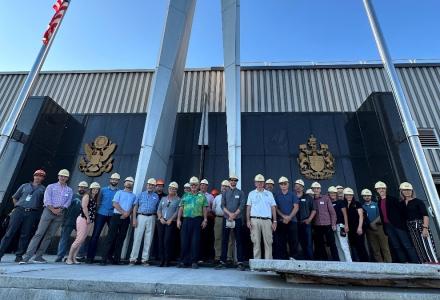
Construction may begin as soon as 2020 on FishPass, a first-of-its-kind fish sorting system to be constructed in the Boardman River in downtown Traverse City, Michigan.
FishPass, the capstone of a 20-year restoration project on the river, will replace the deteriorating, Union Street Dam while aiming to solve one of the world’s most difficult fishery management challenges: how to pass desirable fish around barriers and dams while simultaneously blocking harmful species like the sea lamprey.
The Great Lakes Fishery Commission unveiled the final design for the project earlier this year. It’s the culmination of more than three years of work by more than 50 fish passage experts, fish behavior and ecology experts, engineers and hydrologists. Community and stakeholder input also was essential.
FishPass will have an attractive and unique labyrinth weir to block sea lamprey and other invasive fish. It also will separate the city’s downstream area into a fish-sorting channel to test techniques and technologies such as water velocity barriers, light guidance, video shape recognition, eel ladder style traps, and a natural river channel for recreation and normal river flow. The location will be an improved city park containing a world-class technology and research center.
The project was featured on a tour of Traverse City before a recent IJC public meeting on Great Lakes water quality.
Dam Good or Dam Bad?
Dams and barriers are often considered positive landscape features because they can generate power, provide recreational opportunities and prevent contaminant and disease transfer upstream in an aquatic system. Of paramount importance to the Fishery Commission, they also block invasive species such as sea lampreys.
But dams can hinder ecosystem function by reducing species richness, fragmenting habitats and impairing animal movements. For these reasons, efforts to remove dams and barriers to improve aquatic connectivity have gained significant momentum in the last decade. The Fishery Commission, however, has continuously maintained that removal of barriers that function to block sea lampreys—each one of which will destroy 40 pounds of fish—cannot be achieved without causing devastating damage to the Great Lakes fishery.
Addressing the tension between improving aquatic connectivity and using dams for invasive species management is one of the greatest issues facing the Great Lakes. Besides labor intensive trap-and-sort operations, a solution to remove invasive fishes and provide upstream access desirable species remains elusive. Do we have to accept this undesirable status quo? Those working on FishPass don’t think so; we have confidence that technology can be developed to automatically sort fish so that desirable species can pass an obstruction while also stopping destructive species like sea lampreys.
Research efforts at FishPass will be coordinated by an advisory board with representatives from organizations including the Michigan Department of Natural Resources, US Army Corps of Engineers, Great Lakes Fishery Commission, Traverse City, Grand Traverse Band of Ottawa and Chippewa Indians, US Fish and Wildlife Service, US Geological Survey, Fisheries and Oceans Canada, Ontario Ministry of Natural Resources and Forestry, and collaborating academic institutions.
Once optimized for bi-directional (up and downstream) selective fish passage (about a 10-year endeavor), FishPass will be converted to a permanent selective fishway. Lessons learned from the optimization phase will be applied to similar rivers to create selective fish passage at new sites. It is expected that FishPass will have regional, national and global implications.
For more information about FishPass visit the Great Lakes Fishery Commission’s website.

Jill Wingfield is communications program manager with the Great Lakes Fishery Commission.




